Masterpiece Story: The Rainbow Portrait
Queen Elizabeth I is known throughout history as one of the most famous British Queens. Even without a husband, she successfully ruled England for 45...
Anna Ingram 8 July 2024
In the 1550s and early 1560s, Titian attempted to deliver a series of seven large canvases to King Philip II of Spain. Each translated a small section of the epic poem Metamorphoses by Roman poet Ovid, into paint. Titian coined the term “poesie” to describe them: paintings could be classified as poems.
People consider these seven “poesies” as some of Titian’s most magnificent work and accordingly, we shall meet each one in chronological order in this article.

Titian’s establishment as the one-to-watch among the upper echelons of Italian society reached a high point when he met with the Holy Roman Emperor Charles V in 1530. This propelled him into the imperial court and led to the royal commission of paintings from Ovid in the 1550s.
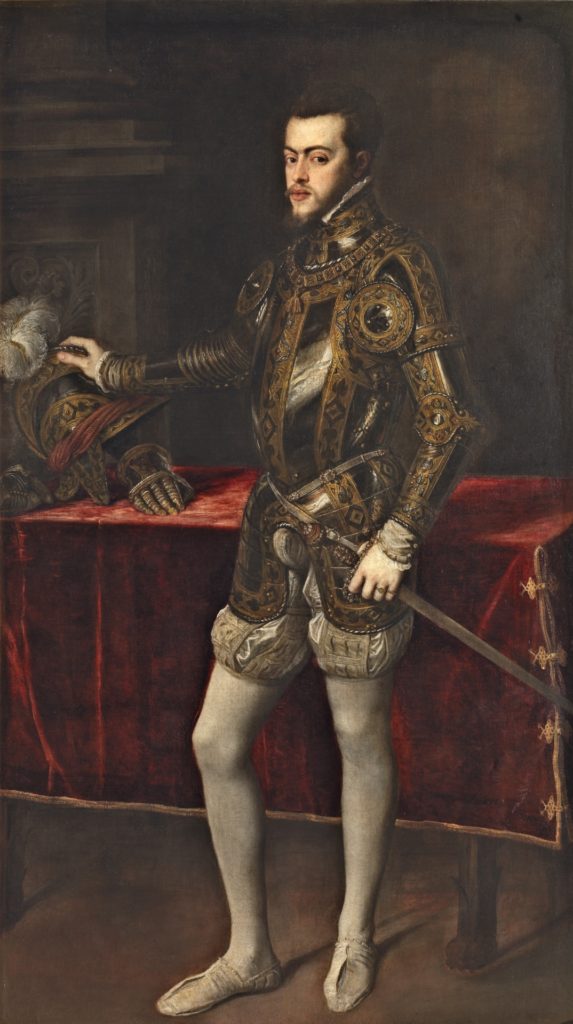
Titian, in fact, offered the series of Ovidian poetry paintings to the Pope but was turned down. He met Philip II of Spain in Milan and Augsburg, both times painting the prince’s portrait and presumably confirming the ambitious project.

Danaë, an only child and a princess of Argos, faced a prophecy that foretold her son would eventually slay his own grandfather. To prevent this, Danaë’s father confined her. Nevertheless, the god Jupiter, known for his lust for mortal women, transformed into a shower of gold to be intimate with her. From this union, Danaë bore a child, Perseus, who later beheaded Medusa and, using her severed head, turned his grandfather into stone.
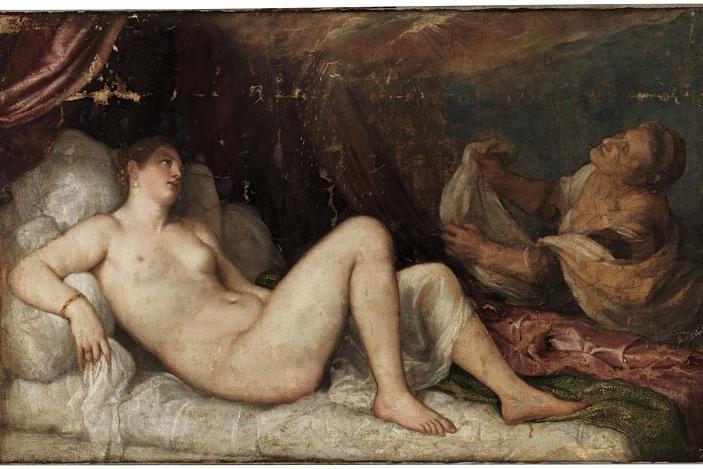
Titian’s rendition emphasizes the myth’s gold shower episode, which aligns with Ovid’s narrative in chapter IV of Metamorphoses. Titian produced this composition at least six times, from 1544 to the 1560s. Scholars concur that the version currently housed in The Wellington Collection in London was the one intended for Philip. Notably, in this version, an elderly woman, rather than Cupid, approaches Danaë. Additionally, unlike other iterations, there is no drapery on her upper thigh.
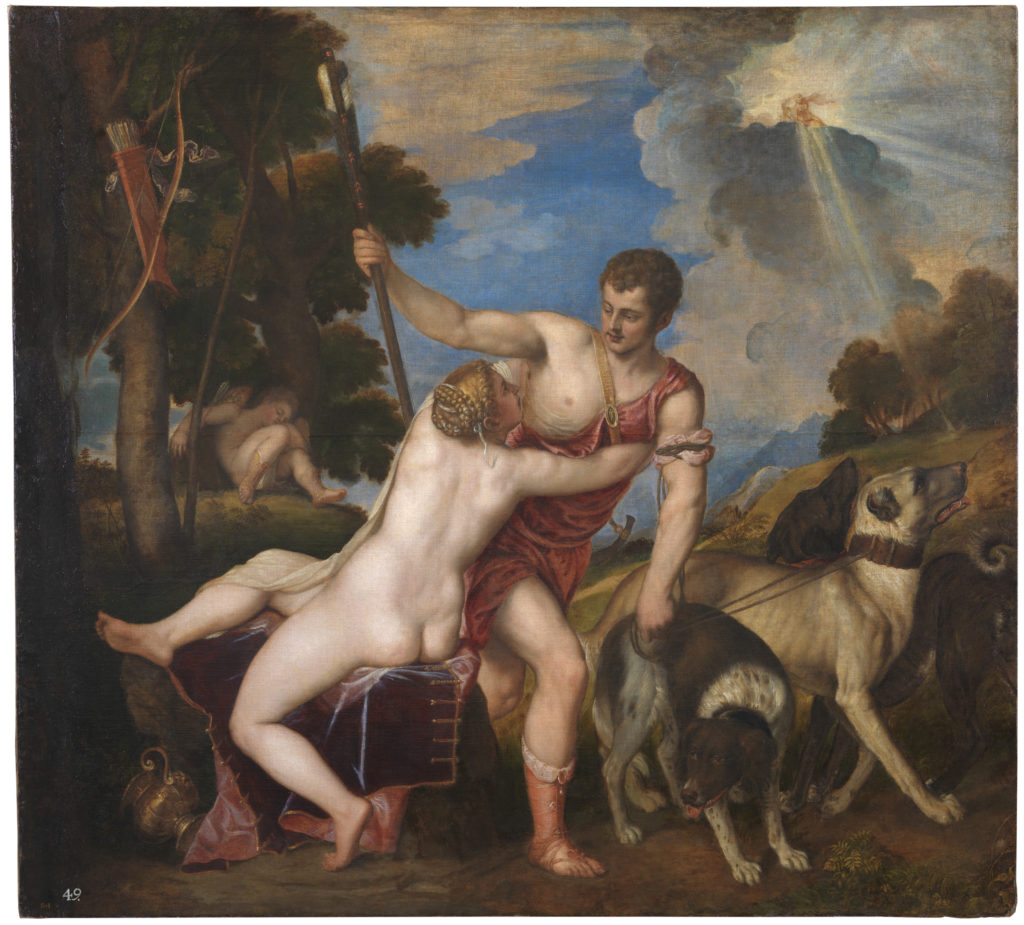
The goddess of love (Venus, Cupid’s mightier mother) is the focal point of Titian’s next poesie. The mortal hunter, Adonis, is being accosted by nude Venus. In the background, Cupid can be seen peacefully sleeping, with his bow and arrows hung on a nearby tree. According to the myth, Venus’ has been accidentally stung by the arrow of love, causing her to be infatuated with a mortal.
Venus has told Adonis, who was off hunting, to be careful of lions and boars as they have a grudge against her. Adonis asks why, to which Venus replies:
“But now the unaccustomed effort tires me, and, look, a poplar tree entices us with its welcome shade, and the turf yields a bed. I should like to rest here on the ground,” (and she rested) “with you.” She hugged the grass, and him, and leaning her head against the breast of the reclining youth, she spoke these words, interspersing them with kisses.
Ovid, Metamorphoses, X. 554-559.
Despite listening to her warning tale, Adonis still continues with the hunt and indeed does get gored by a boar. Perhaps, then, the sleeping Cupid is also a symbol of Adonis’ ignorance of Venus’ entreaties.
Once again, there are multiple versions of this painting. However, Venus and Adonis outdo the others with around 30 (!) different known versions. There is a date for only Philip’s version because it is documented in a correspondence. In the letter Titian explained that Venus and Adonis would compliment Danaë, offering both the front and back of a nude. He said that this allowed the pair of canvases to compete with sculpture! The sitting female bottom was very erotic at the time because of its relative novelty.
Swooping down from the sky the hero Perseus (yes, the very same son of Danaë) attacks a sea monster. The death of Andromeda was an order from the gods as a punishment for her mother, who had said she was more beautiful than Nereids. On the distant shore, her family watches the epic scene:
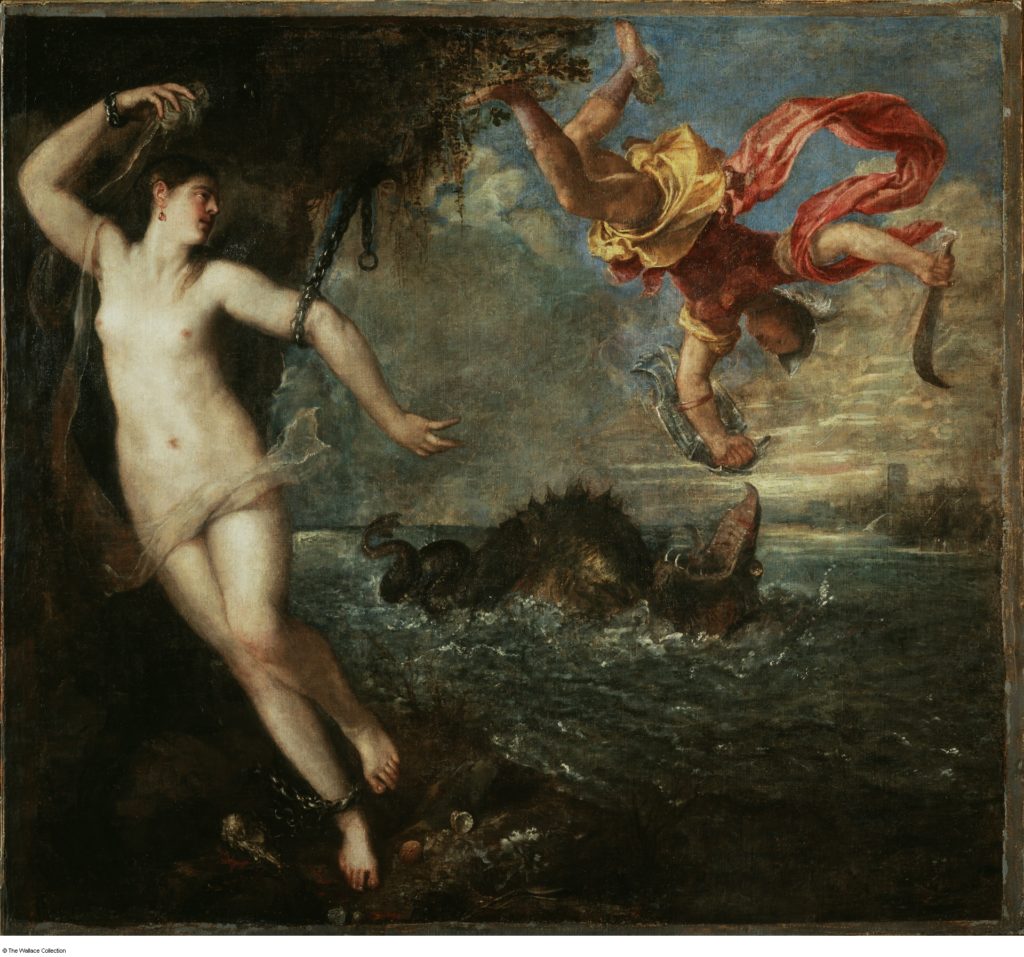
See how the creature comes, parting the waves with surging breast: like a fast ship with pointed prow ploughing the water, driven by the sweat-covered muscles of her crew. It was as far from the rock as a Balearic sling can send a lead shot through the air, when suddenly the young hero, pushing his feet hard against the earth, shot high among the clouds… so the descendant of Inachus hurling himself headlong, in swift flight, through empty space, attacked the creature’s back, and, as it roared, buried his sword, to the end of the curved blade, in the right side of its neck.
Ovid, Metamorphoses, IV. 706-723
The best preserved of all of the Poesies is the Rape of Europa. It is another story of Jupiter (Roman equivalent for Zeus) consummating his desire for a female mortal in a changed form: this time a bull, instead of a shower of gold. According to the myth, Europa and her girlfriends were hanging about on the coast when a beautiful bull (Jupiter in disguise) distracted Europa and eventually lured her out to the sea, abducting her.
Then he goes further out and carries his prize over the mid-surface of the sea. She is terrified and looks back at the abandoned shore she has been stolen from and her right hand grips a horn, the other his back, her clothes fluttering, winding, behind her in the breeze.
Ovid, Metamorphoses, II.872-875
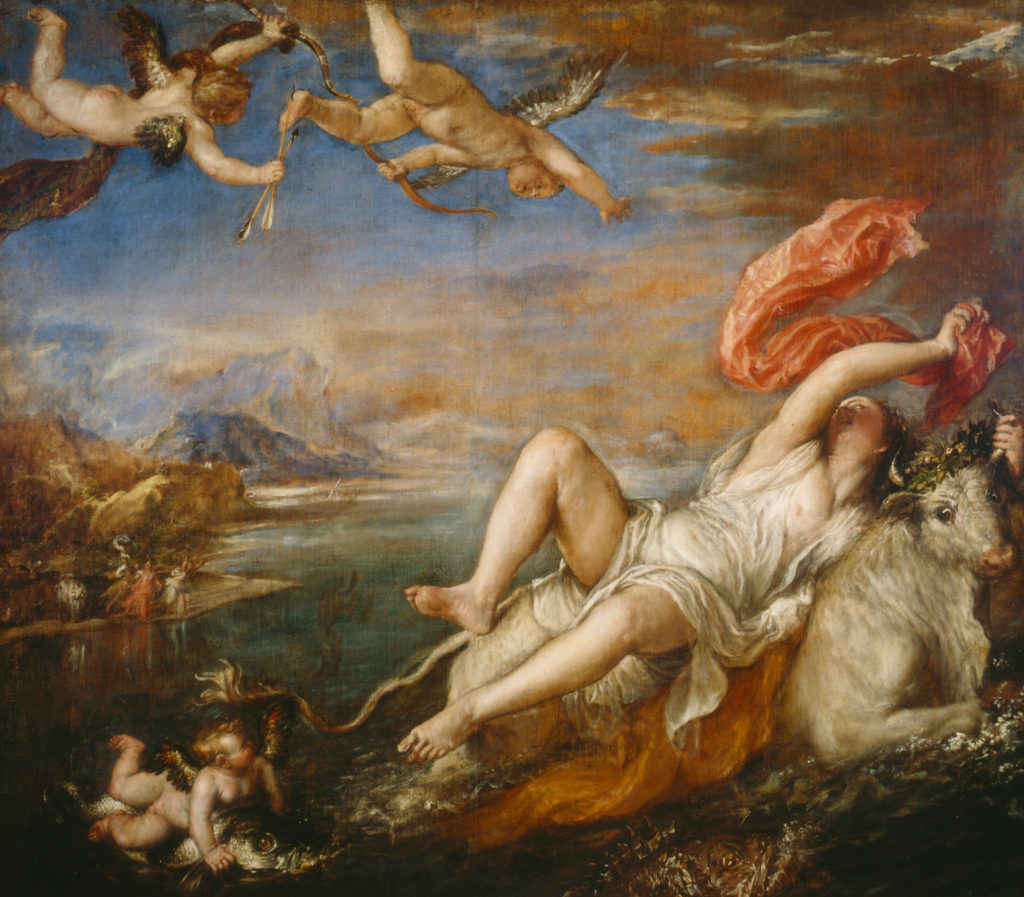
Titian makes Europa’s distress very clear and uses the opportunity to revel both in the colors of a sunset and in portraying the motion of the waves and fabrics in the scene. In the foreground, you can see that Titian has added a scary sea monster into his rendition of the myth, possibly to make it a pairing with Perseus and Andromeda. Another shared aspect of the two is the group of concerned observers visible in the background of both paintings.
While Diana is bathing there, in her accustomed place, Cadmus’s grandson, free of his share of the labour, strays with aimless steps through the strange wood, and enters the sacred grove. So the fates would have it.
Ovid, Metamorphoses, III.173-176

Diana can be found on the right-hand side; she is wearing a half-moon diadem and sitting on some luxurious velvet while having her feet washed. She shields her naked body from Actaeon. Titian makes her anger clear and contrasts it with the concerned expression of the nymph closest to the blundering intruder. The pool of water is still and reflective, but not for long: the goddess splashes it into Actaeon’s face, the splash transforming Actaeon into a stag. As a result, Acteon will be ripped apart by his own hunting dogs.
Unlike the preceding scenes, this poesie shows both a male victim and multiple female nudes, rather than just a single of each. Diana and Actaeon showcases Titian’s dexterity in composing the female nude. This is ironic considering that the painting tells a story where a viewer is in fact punished for seeing nudity.
Callisto, a nymph, finds herself pregnant after the god Jupiter tricked and raped her. This presents a significant predicament, as she is a devoted follower of Diana, committed to maintaining her virginity. Her pregnant condition is brought to the attention of the chaste goddess Diana by the other nymphs. In response, Diana decrees Callisto’s exile.
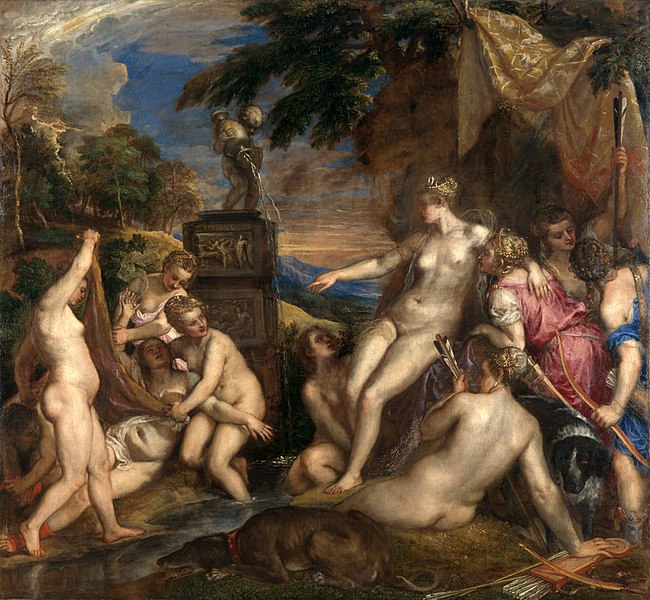
Nine crescent moons had since grown full when the goddess faint from the chase in her brother’s hot sunlight found a cool grove out …. “let’s bathe our bodies naked in the flowing water.” Callisto blushed: all of them took off their clothes: one of them tried to delay: hesitantly the tunic was removed and there her shame was revealed with her naked body. Terrified she tried to conceal her swollen belly. Diana cried ‘Go, far away from here: do not pollute the sacred fountain!’ and the Moon-goddess commanded her to leave her band of followers.
Ovid, Metamorphoses II. 453-465
Once again, the scene abounds with female nudes. Titian had the opportunity to portray a pregnant woman’s physique and chose to make it fairly grotesque. Like in Diana and Actaeon, the gaze of each figure is in a different direction and holds a very individual expression.
Intriguingly, The Death of Actaeon never actually made its way to the king. For some reason or another, it remained in the artist’s studio until his death in 1576. In later life, Titian began to revise his own style, and we can see this change, such as a more liberal use of brush strokes, in this painting, which continues the story of Actaeon’s punishment from the painting Diana and Actaeon.
But when he sees his head and horns reflected for certain in the water, he tries to say ‘Oh, look at me!’ but no voice follows. He groans: that is his voice, and tears run down his altered face. Only his mind remains unchanged. What can he do? Shall he return to his home and the royal palace, or lie hidden in the woods? Shame prevents the one, and fear the other. While he hesitates his dogs catch sight of him.
Ovid, Metamorphoses III. 200-206
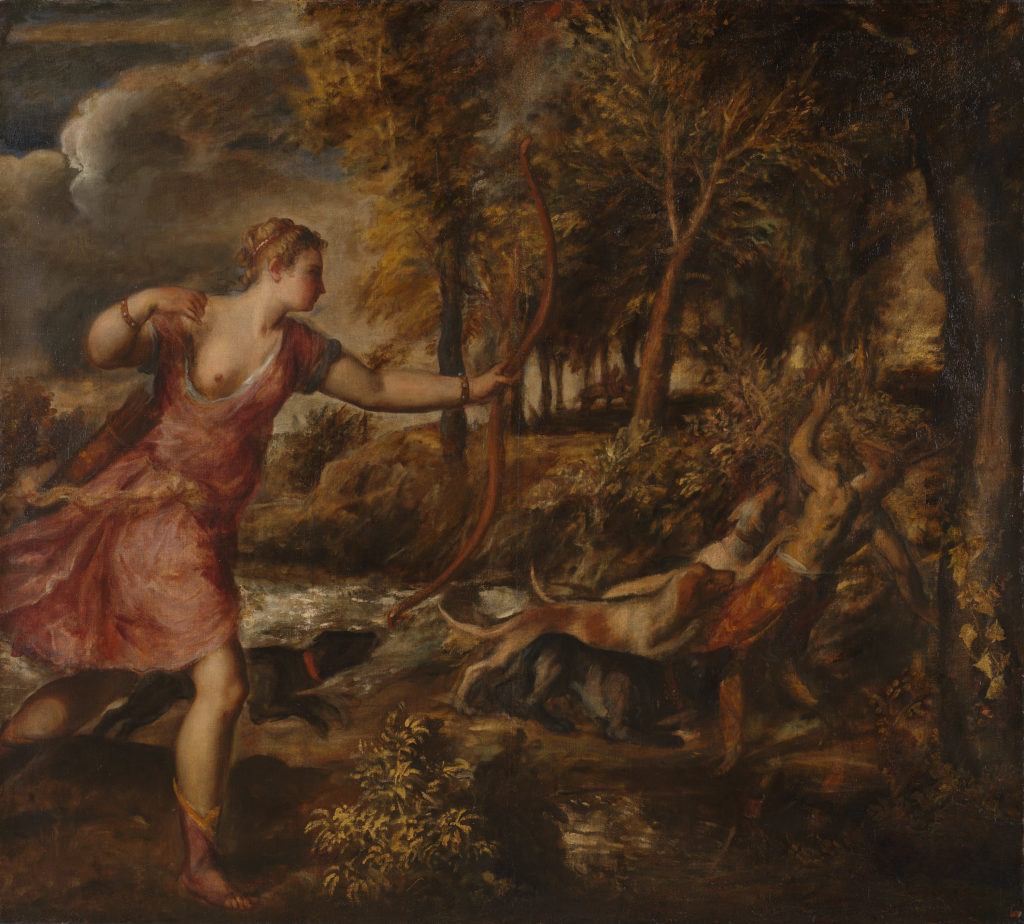
DailyArt Magazine needs your support. Every contribution, however big or small, is very valuable for our future. Thanks to it, we will be able to sustain and grow the Magazine. Thank you for your help!